NSFWare (Review)

Price: £2.09
Source: Cashmoneys
Where To Get It: Steam
Sexual content contained in this game includes toys, cuckoldry, bdsm, voyeurism, and multiple partners. (more…)

Price: £2.09
Source: Cashmoneys
Where To Get It: Steam
Sexual content contained in this game includes toys, cuckoldry, bdsm, voyeurism, and multiple partners. (more…)

Source: Cashmoneys
Price: £19.49
Where To Get It: Steam
2018 continues to be a year of firsts for me saying words I never thought I’d say. In the case of Distance, spiritual successor to Nitronic Rush, those words are “Wow, I never thought I’d see a good horror game in the Future Racing genre.”
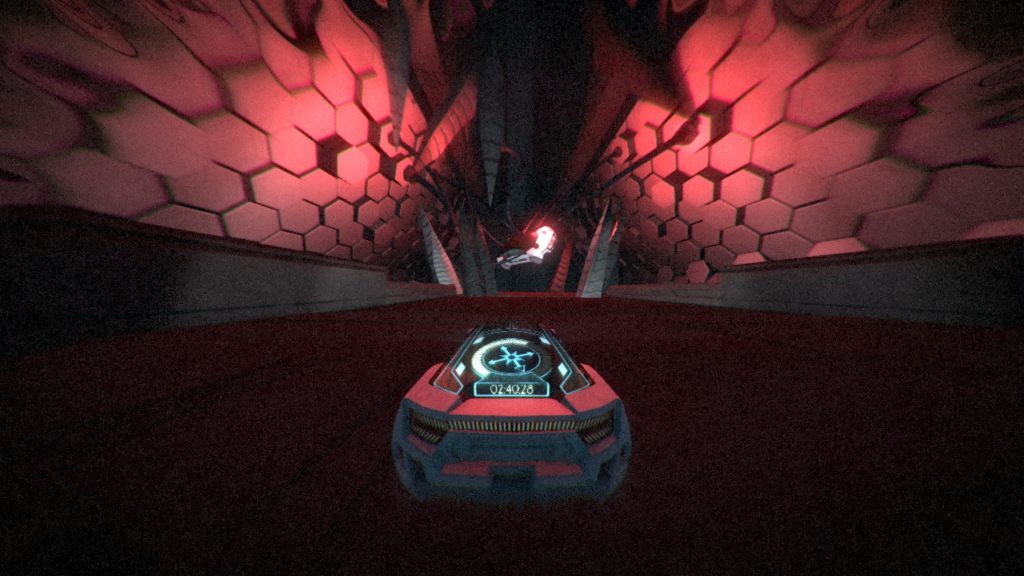
Grain, spooky thing in the distance, ambience? Yup, that’s… Waaaaaait…
And yet… Here we are. A Future Racing game involving a car that can fly, tumble, and make sharp turns without braking… Also being a game with horror stylings, unsettling the player with strange vistas of a world gone horribly wrong, shining hope transmuted to despair. Without a single human character, only a car, a road that inexplicably seems to want you dead, a teleporter, and a rogue machine… OR IS IT?
Okay, so it gets a little odd and ambiguous at times, and I’m not 100% sure I can give the game props for horror writing when I haven’t completely played through the second campaign, but moodwise, it definitely creates feelings I’d associate with horror: Uneasiness and dissociation, asking myself… What’s really going on?
It also helps that it’s a smooth game. While I would recommend controller over keyboard for Distance, if only because the control scheme is a little odd, the keyboard controls are, nonetheless, quite smooth, and I only ever felt a little put out during the quicker, more difficult segments by the aforementioned control scheme (Quickly hitting SPACE, A/D, and SHIFT in the right timings was a little bit frustrating. Only needed late in the main campaign, and I’m sure rearranging keybinds could help.)
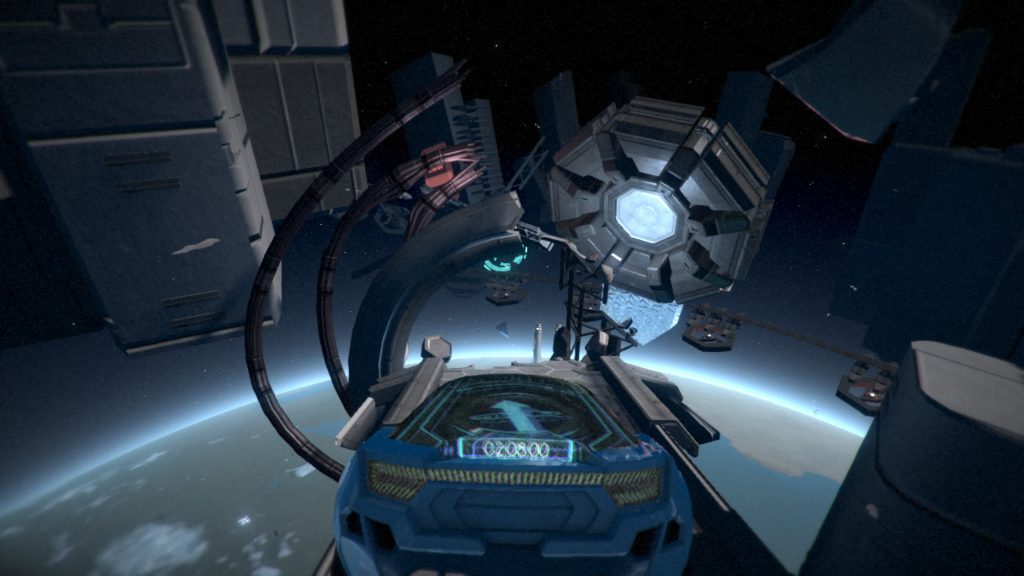
While flying is relatively rare, the cold, deep depths of space aren’t. They’re breathtaking. Well, they would be if cars had lungs, anyway…
Aesthetically, the game is on point pretty much throughout. Good signposting, clear visuals, and a dystopian retrofuturist aesthetic that works well whether it’s ruined or not, I never felt distracted. Musically, it switches well from pumping electronic beats to more ambient, horror styled soundscapes, and the sound effects and voice work well.
So… So far, I’ve been pretty glowing about Distance. And it is a good game. It helps that it also has a track editor and Workshop support, but one thing I will say is that I don’t really feel like the campaign added a whole lot to flying before it’s taken away from you for the majority of the rest. Part of that, I get, flying is hard, and inverting the vertical controls is a bit of a shock if you aren’t prepared for it (My exact words were, as I recall “Friends don’t let friends invert on you.”), but it was somewhat disappointing to see flying under-represented. But other changes from the original formula, such as a “down” thrust (that’s “down relative to your car”) are definitely welcomed, and I did, overall, find enjoyment in doing some of the silly things you can do with your jumping, thrusting, tumbling electronic car before the end of its main campaign.
And that, honestly, is about all I can say, because the game is simple and tight, elegantly tutorialises, and is fairly accessible to boot. It’s got some interesting horror elements that feel natural, and is well worth a look from the Future Racing crowd.

Another improvement over Nitronic Rush… These spikes didn’t want to make me throw my control-device out of a window.
No, for reference, Twisted Metal doesn’t count, because it’s a Combat Racer. Small diff.

Source: Cashmoneys
Price: £15.49
Where To Get It: Steam
When you’re the sole reviewer, it becomes ever more important to separate not liking something for genuine problems, and not liking something because you’ve grown tired of certain genres and their conventions. While, normally, a writer can just recuse themselves, occasionally, something interesting comes along that requires, partly, putting aside that dislike.
Lucah: Born of a Dream is one such game. A deliberately lo-fi adventure, with a top-down false perspective, and… Soulslike combat, levelling mechanics, and saving via specific resting points. The latter of which I have, over time, become somewhat tired of.

YOU DIED [Your Corruption Has Risen]
Maybe that’s viewing it through the lens of my own depression. The world is mostly black and “not-black” , harsh, scribbled tones, and its moderately plodding tone outside of combat emphasises that this is a world seen on its way out, a world that’s… Keeping on, rather than thriving. It’s clever, and while it hits a little close to home for me, I can appreciate the artistry behind it. Similarly, the game has a sort of time limit on each “run” , as Corruption is slowly building (quicker the more you die, slowing as you beat fights), and when it reaches 100% ? Well, back to the beginning, you failed. Sorry.

It’s just… The way things are. Give in.
Combat, meanwhile, is also deliberate, but less plodding. In fact, it can get downright hectic at times, and it’s here that I have to separate my more generalised dislike from the few actual problems it contains. You see, for the most part, it works, and is clever. Two loadouts you can quickly switch between, each containing three elements: Your light attack, your heavy attack, and your support option, meant to buy time for your stamina to regenerate. Attacks lock you into their animation pattern, and, as you progress, you gain more abilities, some of which require using limited skill slots ,Virtues, and some of which you can turn on or off as you feel, the Tech… Turning these off appears mostly to be a challenge thing, as it includes things like the dodge parry. Speaking of…
When it works, it works well… Enemies clearly telegraph their attacks, there’s a variety of ranged and melee attacks that keep you on your toes, and the spaces range from large to confined, so there’s a lot of tactical variation. Changing your Mantras and Familiars for different loadouts of attack is definitely encouraged, as is experimenting with them to see what fits your style best. But it’s at this point that I have to mention some jankiness.
Sometimes, although I don’t fully understand why, my attacks will lock onto a specific enemy (I may have fatfingered a lockon there), and this leads to frustration as… Dammit, I was aiming for that one, not that one! Similarly, dodge timing takes a little getting used to for parries, because while often, enemies will telegraph their attacks, the telegraph is not the moment you dodge toward the attack.
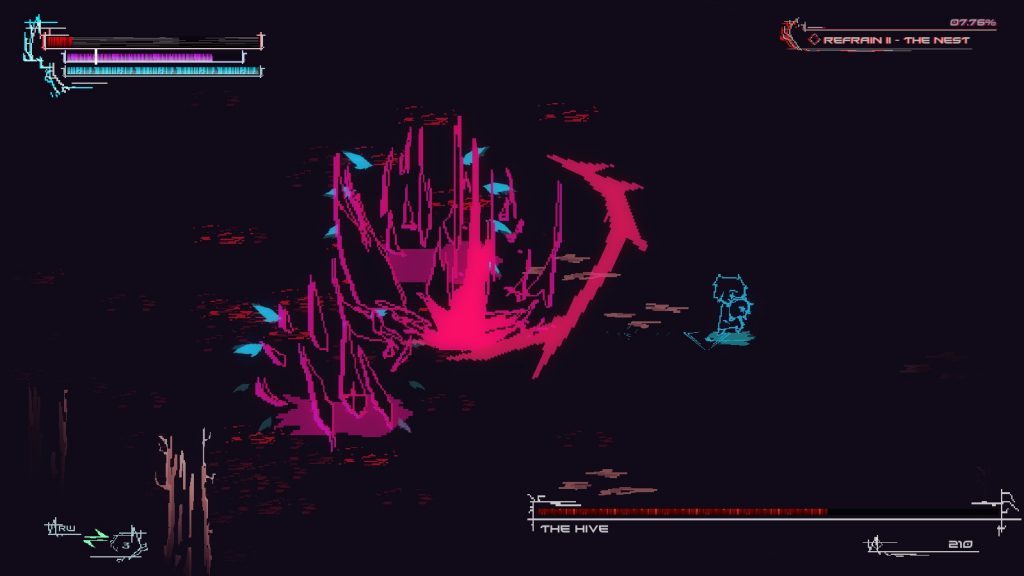
Boss battles definitely live up to their name, and each has a different, interesting touch.
The actual attack is, and it’s at this point that I mention a controller is probably a good idea for Lucah, since I’ve found, on keyboard and mouse, dodge parrying a little too finicky, because yes, you do have to dodge specifically into the attack to trigger it, and that’s easier to handle with the more granular nature of an analogue stick.
The rest of my gripes with this game, quite honestly, you can simply note as gripes with the Soulslike formula, and more to do with genre weariness than any actual fault of the game. As such, it overall gets a recommendation, because it does interesting things with the genre, and has a somewhat unique aesthetic and narrative that, overall, works. Definitely one of those cases where, even weary as I am of the You Died bullshittery, I appreciate the artistry the Lucah team have brought to bear here.

Eesh. Only way to progress, huh? Chilling.
The Mad Welshman must rest. He is tired.

Source: Cashmoneys
Price: £9.99
Where To Get It: Steam
Ghostly Matter is one of those games where, with its retro stylings and cool ideas, I want to like it. Mixing old action adventure titles (Not the modern definition, but essentially, platformers with adventure game elements), pulp horror, and survival horror.

Two professors, both alike in dignity…
But a common problem, it seems, with retro games is that they also take the less laudable elements of retro design, and Ghostly Matter, for all that it has an interesting world, won’t particularly let me get into it because it wants to be retro hard.
The general story is, admittedly, nice and pulpy. Two professors, both alike in dignity, work in the burgeoning field of ghostly research, but they split over an argument about whether something that lets you look into the abyss that is the realm of the dead will also let the abyss look into them. Years pass, and Dr. Penderghast, the protagonist, receives a mysterious message from beyond the grave that seems to be his old professorial friend. Cue horrors and hijinks.
I’d love to tell you more about those hijinks, about the direction the game goes, but, unfortunately, I can’t. Because there is a lot of dying in this game, and checkpoints… Are not terribly helpful. Fixed life with few healing items contrasts with contact damage, rapidly firing enemies, the fact that your Spectroscope is necessary to see certain enemies, but also drains your health at a rate of knots (and needs batteries) … Before we even get into things like the gotcha that opens up a shortcut in the second level, where you open up said shortcut, jump down, and… Are immediately assailed by four skeletons arising in very close proximity. Whups, opening this shortcut is going to cost you health, no matter what you do. What’s that? Your health is in short supply? Better remember where the nearest checkpoint is, then!

In game design philosophy, there is the problem of Schrodinger’s Monster Closet. When the waveform collapses, you either take damage or have an item (its usefulness also determined by a waveform.)
There are other, better weapons that, unfortunately, but I can, at least, tell you there are three different types of enemies, and certain weapons work better than others. But when maps are large and sprawling, health items are few and far between, checkpoints are equally pretty far… And the enemies like to be invisible (use the spectroscope to hit them, lose health anyway, because the spectroscope is a gateway to death), or pop up from the ground (with some being easy to spot, others not so much) or just have hard to dodge ranged options, I found myself hitting brick walls pretty often, to the point where I’m writing this review without having gotten nearly as far as I’d like.
Oddly, narratively, everything fits together well. The supernatural world is tough (enemies are bullet spongy) , the spectroscope drains life with use because it’s basically a gateway to the spirit realm (but is necessary for puzzles, while health items are rare) , and you can’t exactly have a horde of evil in a small room (maps are large, with only a few navigation aids.) Mechanically, as those little asides note, it doesn’t work so well, with a lot of factors contributing to the difficulty, while less factors ameliorate it. The controls are also a little tough to get into, sadly, but this is not a huge issue when a lot of the time, what you need is move, jump, and shoot, all of which are simple enough.
Still, it is an interesting story, and while I have a lot of trouble with it, if you’re fine with games being tougher than usual, this may be one to look at.
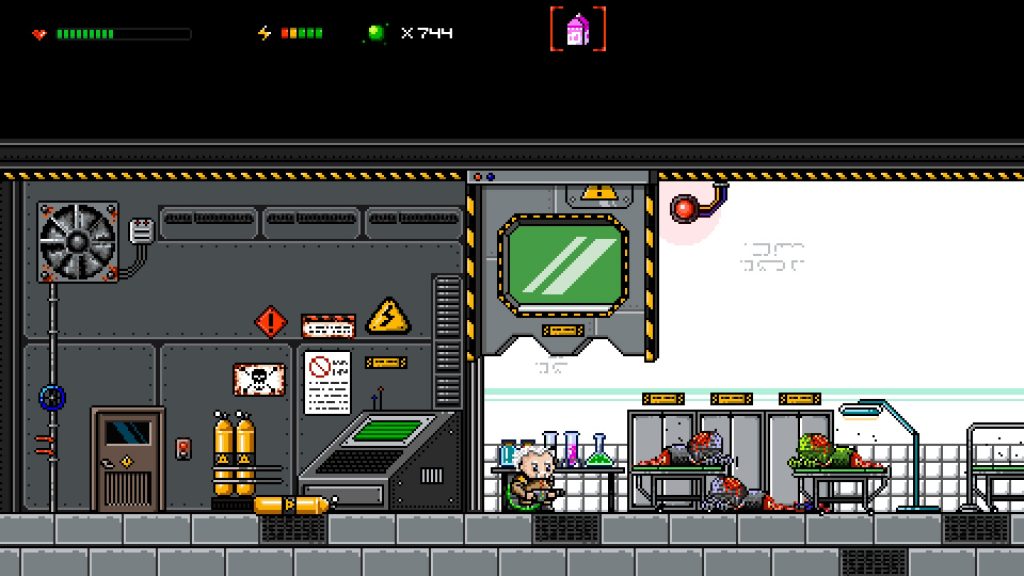
Even in the areas I’ve been able to struggle through, there’s at least some variety. From a normal house to… This. Cool!
The Mad Welshman loves him some horror. It’s part of why he’s often so harsh with horror titles, it must be said.

Source: Cashmoneys
Price: £19.49
Where To Get It: Steam
Being an Archaeologist is, in many senses, about being observant. Clues can be as subtle as a passage in a book, the curvature of glacially moulded hillscapes, or the precise composition of a flint arrowhead, and it’s important to be able to see, to understand what you’re seeing. Being a Ninja, if we go by popular depictions or otherwise, is about being observant. Being a covert agent is all about what you perceive, about how quickly you can sense danger, and, equally, about seeing opportunity where others merely see a surly major-domo (for example.) In both cases, livelihood (and sometimes, your life) depends on being able to clearly see the clues set in front of you by circumstance.

“Do not pursue Le-Meza!” doesn’t have quite the same ring, but yes, the protag’s dad always seems to be near the most devlish traps. I’m in the *POISON LAVA* on the left. Terrible parent, I swear…
And so, funnily enough, it is with La Mulana 2, a game that does explain its puzzles… It’s just not always in the places you’d expect. This is less surprising when you consider that the only family line to have successfully explored the La Mulana ruins (and, with your control, hopefully explore the Eg-Lana ruins that seemingly coincide with them) is a family of… Archaeologist Ninjas. Lemeza and Shawn, from the last game, and, the main protagonist of this game, Lemeza’s daughter Lumisa.
So, for those just catching up, La Mulana was, and is, a love letter to the MSX (One of Microsoft’s early attempts at “A computer on every desk” , an 8-bit system that found popularity in quite a few places, but most notably Japan and Brazil), and the action adventures that could occasionally be found on the system. It’s an action platformer, but with puzzles of all stripes, some of which will kill the unwary instantly, a variety of enemies, and, of course, bosses… Some of whom will kill the unwary instantly. Save early, save often, and investigate things. Oh, except that tablet. They told you not to read that tablet for a reason, don’t do that. That’s the Hard Mode Tablet.
Don’t say I didn’t warn you. Or that the game didn’t.
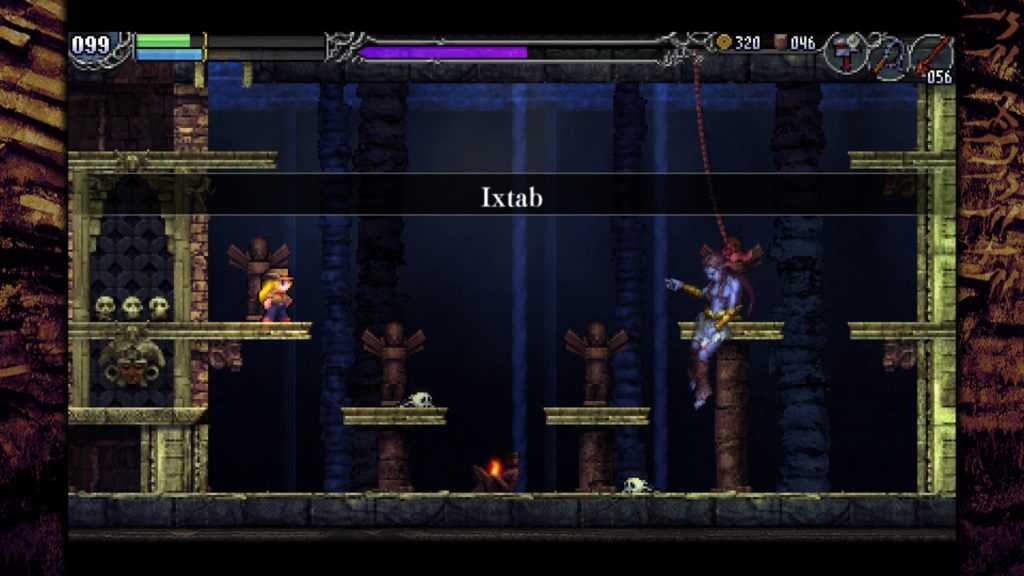
Bosses and NPCs alike take from a variety of mythological sources, from the Aztec, Mayan, Norse, and Celto-Gaelic cycles. Ixtab, for example, is the Mayan goddess of… Well, you can probably guess. 😐
Overall, La Mulana 2 is a more focussed, somewhat improved version of its predecessor. Awkward to no air control has become “A little air control” (and jumping puzzles designed around this), the early game is less punishing (You can, with just a little prep, take on all the minibosses and boss of the first area without serious weapon upgrades), the writing’s improved a little, and the art style is about the same as the remaster of La Mulana 1 (Solid pixel art, combined with some amusing hand-drawn characters for the conversations.) It controls relatively well (although the keybinds take some getting used to, and, even as an 8-bit kid, it took me a short time to figure out that F2 is for inventory, settings, and apps, and F1 is for conversation, the area map (if you’ve found it), and the area teleport interface. Swimming is still somewhat painful, alas, but we can’t have everything.
Thing is, La Mulana 2 does exactly what it sets out to do: Be a tough, but mostly fair adventure platformer, with a sometimes humorous, sometimes tragic setting where not only were all myths real, they all had a single source, a progenitor who, as it turned out, just wanted to go home… And the world ending threat she represented. So, on the one hand, this review is very much a “Does what it says on the tin”, and, considering the Kickstarter campaign was on the platform of “Back this, and I will make a game that kills your character repeatedly” (not the exact words, but close enough), and the first game worked on exactly this notion… Yes, it does what it says on the tin. But I thought I’d finish up this review by describing the core loop of gameplay, because most people who get turned off by the game get turned off by the second part of the loop, and maybe hearing it will help.
At first, everything is very simple: You’ve opened doors, you’ve got the map to the area, you’ve remembered to ensure you can teleport to the area (by scanning the holy grail you normally save with), and you’ve killed pretty much everything you can kill that stays dead, such as minibosses. Good on you… But of course, the game isn’t over, and the question then arises… Well now what?
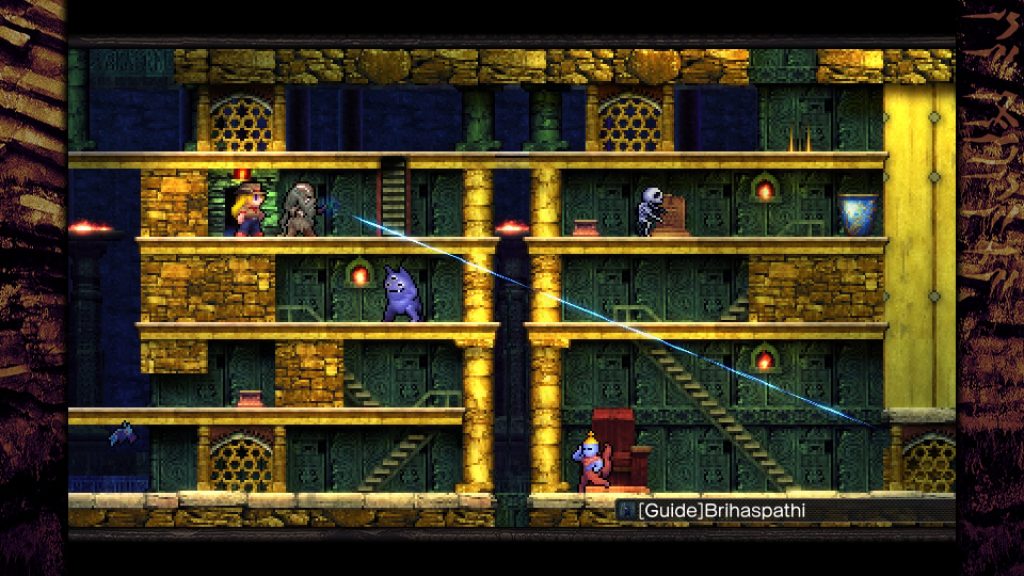
Once you’ve figured out part of the puzzle, the rest tends to fall into place. Which, let’s face it, is a good feeling.
Well, now you need to go somewhere new, solve some new puzzle, obviously. And sometimes, it seems like there’s no way forward. One optional example here is the chain whip. It’s a useful weapon, like your whip, but does double the damage, which is just enough not to hear the dreaded “tink” of “Haha, nope, this enemy didn’t even feel that.” But getting it involves observation, and the fact that you have water (poisonous), ice water (poisonous and cold), lava (hot), and poison lava (hot poison, and no, I’m not joking. Poison lava. Just for added “Screw you.”) All I will say is that identifying which is which is very valuable in determining whether a path is suicidally impossible… Or do-able, providing you know how to deal with the swimming. This is one example of where the way forward is there… You’re just not seeing it. Drawings on tablets give you hints to what these cryptic texts are talking about. Tablets tell you about things… Walls can look different, maybe crumbly, maybe hollow.
And then you find a way forward, and it probably kills you, because of something you hadn’t seen before. Sometimes it’s a miniboss. Sometimes it’s a new enemy. Sometimes, it’s gotcha traps, which, I’ll grant you, are a turn off (although even these mostly give clues to their presence… Even if the clues, sometimes, are bait.) But you know a way forward. Due to the relatively nonlinear nature of the game, it doesn’t even have to be the same path your friend took (I got two sigils before my friend did, but had to look at his footage to see where the hell the chain-whip was, for example.)
That, in the end, is the core of La Mulana 2: Explore, probably die a lot, save often so the deaths set you back less, find clues, find cool items and mythological beings to talk to (or fight), solve those puzzles, beat those bosses, eventually save the world, hopefully have a good time doing so. Despite being horribly stuck, I’m having fun, and I hope folks who get the game (if they do after reading this) enjoy it too, because while it’s sometimes old school, it’s a lot more fair than the old-school I’m used to. Looking at you, old text adventures… BITE LIP… Who the hell thinks BITE LIP is the proper solution to a puzzle, I ask you…
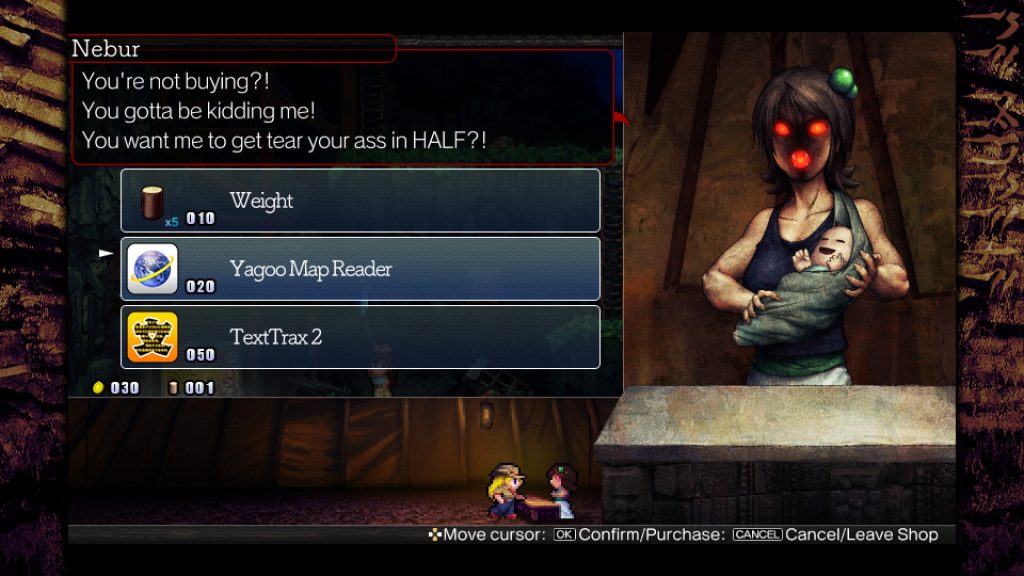
Even returning characters get some impro-H GODS, ALRIGHT, I’LL BUY SOME WEIGHTS, JUST DON’T HURT ME!
The Mad Welshman will draw the curtain on this review, to save you from a rant about the bullshittery of old text adventures… For now.